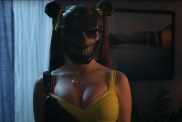Giovanna Mezzogiorno as Sabina
Alessio Boni as Franco
Stefania Rocca as Emilia
Angela Finocchiaro as Maria
Giuseppe Battiston as Andrea Negri
Luigi Lo Cascio as Daniele
Valerio Binasco as Padre
Francesca Inaudi as Anita
Lucy Akhurst as Ann
Directed by Cristina Commencini
Summary:
Part Italian soap opera, part Hitchcock psychological thriller, this Italian drama goes off on too many tangents from the central story with many irrelevant subplots that might actually have been decent movies on their own.
Story:
Sabina (Giovanna Mezzogiorno) is a young woman with a good job and a loving boyfriend, Franco (Alessio Boni), but for some reason, she can’t remember her parents or how they died. She starts having nightmares about an incident from her past, and when she learns she’s pregnant, she flees to America to get answers from her brother, leaving Franco and her other acquaintances to fend for themselves without her.
Analysis:
I constantly hold up hope that Italian cinema will have a renaissance, since the country has such a rich film history. Once in awhile, a really strong movie comes around, but Italy’s latest offering, its Oscar nominated film no less, is not the movie that will change opinions about the rambling pretensions that the country’s cinema has offered since the latter days of Fellini and the work of Mastroantonio.
Second generation filmmaker Cristina Commencini adapted “Don’t Tell” from her own novel “La Bestia nel Cuore,” which itself was inspired by a newspaper article about a brother and sister discussing a painful experience from their past. In the case of Sabina, a voice dubbing actress, we get a pretty clear idea that something bad happened to her as a child, by the nightmarish flashbacks she keeps having. Her boyfriend Franco is supportive, but he’s also busy with his own career as an actor, having been hired by a neurotic director to star in a medical soap opera. The incident from Sabina’s past weighs heavily on her, and ultimately, she decides that she needs to visit her brother and his family in America in order to get answers.
Now pay attention, because this is where it starts to get a bit nutty. Sabina’s producer Maria recently divorced her husband, who was sleeping with a woman the same age as their daughter, and Sabina’s close friend Emilia is a blind shut-in, a lesbian, who relies on Sabina’s regular visits to keep her company. When Sabina goes to America, Maria starts dropping in on Emilia, one thing leads to another, and suddenly, we’re following the development of their relationship. In the meantime, Franco has an affair with another actress, confirming Sabina’s greatest neurotic fears.
If this whole thing still sounds confusing than welcome to the world of Italian cinema. For the most part, this slice-of-life drama is not too unlike other things that have come out of Italy in the last few decades, although it really is three films in one, maybe even four. The mystery from Sabina’s past is the most important one, and it should have stuck with that, but the nature of that mystery involves something that bothers me so much that it was hard to truly “enjoy” this.
Although there are similarities to Oscar winning films like “The Barbarian Invasions” and “The Sea Inside,” Commencini’s writing just isn’t up to par, and the talking heads nature of the film tends to drag things down from the get-go. The first third of the film is basically Sabina going from one acquaintance to the next, talking about her problems, but when they start branching off into their own stories, it’s almost as if Commencini forgot that the whole point of the movie was to get to the bottom of Sabina’s traumatic past.
Commencini’s cast is the film’s strongest forte, particularly the rich performance by the talented Giovanna Mezzogiorno, who spends much of the film in various states of distress, but never makes it boring. She’s certainly an actress we’ll be seeing a lot of in the future. The equally lovely blonde Stefania Rocca is equally convincing as Sabina’s blind confidante Emilie, and Angela Finocchiaro offers some of the film’s only comic relief, as she tries to adjust to her first relationship with a woman. Still, the fact is that the subplot between them would have been just as enjoyable as a separate romantic comedy, and it greatly takes away from the serious nature of Sabina’s problems. The same can be said for Franco’s dalliances while Sabina is away.
Commencini makes some other strange decisions, like when Sabina arrives in America, and the movie turns into a bizarre mix of Italian, English and Americans speaking bad Italian. It’s tough getting through this section despite it dealing directly with Sabina’s problems. It’s just not as interesting or well acted as the things going on back in Italy.
Once Sabina finally finds closure with her brotherand honestly, there are no shocks or surprises there–the film jumps ahead a number of months, and Sabina, Franco, Emilia, Maria, and Franco’s director are all on holiday together somewhere, so that all of the stories finally come to a head. It seems like an unnecessary epilogue to tie up loose ends that probably never should have been introduced in the first place.
Despite the obvious problems in storytelling and pacing, this is still a technically competent film that looks great due to the inventive camerawork and lighting by Bertolluci’s director of photography Fabio Cianchetti. That and the production design give the film a retro look with the darker dream sequences shot in a visually stimulating way that heightens the Hitchcock comparisons.
The Bottom Line:
Those who appreciate some of the more esoteric Italian cinema might be able to stick it out for this slice-of-life talking heads film, but with too many characters and needless sub-stories, not to mention a disappointing resolution, even Italian cinephiles might wonder what they watched and why they watched it.
“Don’t Tell” opens in New York, Los Angeles and San Francisco on Friday.










